
An Innovative LNG Carrier Concept
Concurrent with marine industry consolidation on the ship owning, building and supply fronts, increasingly innovative vessels concepts are originating from in-house design teams sitting with the major equipment manufacturers. Single-source supplier is today's mantra on the commercial and military fronts, with companies such as Wartsila leading the way. The company recently published details of an innovative new LNG carrier concept, the Wartsila DF-electric propulsion concept for liquefied natural gas (LNG) carriers, bringing together two technologies: electric propulsion and dual-fuel engines.
Outline of the DF-Electric LNG carrier The Wartsila DF-electric LNG carrier concept is designed for a single-screw vessel with four cargo tanks and a capacity of about 138,000 cu. m. The hull has a transom stern, a single-skeg aft body and a bulbous bow. The propulsion machinery and accommodation spaces are arranged in the stern part. The cargo machinery room is arranged separate from the accommodation space on the upper deck.
Two cargo tank system variants can be applied: membrane and spherical types. Both variants have a length, (bp) of 902 ft. (275 m), breadth of 141 ft. (43 m) and 157 ft. (48 m) respectively, and design draft of 36 ft. (11 m). The main machinery consists of four nine-cylinder in-line Wartsila 50DF dual-fuel engines, each driving an alternator. Each main engine develops 8,550 kW at 514 rpm, giving a total output of 34.2 MW. The main generators feed the ship's electrical network and, through a variablespeed drive system, the propulsion motors. A 500 kW emergency diesel generator set is also installed.
The single, five-bladed fixed pitch propeller is driven by two 13.5 MW AC propulsion motors through couplings and a twin-input/single-output reduction gear. There are also two 1,000 kW bow thrusters. To enhance the redundancy of the propulsion plant, the main engine rooms and casings are divided with a fire-resistant bulkhead. The main engine rooms are under diminished air pressure. A back-up arrangement of a thermal oxidizer is provided to dispose of boil-off gas during long periods of low-load operation.
The service speed of the ship is about 19.5 knots at the design draft of 36 ft. (11 m) and with 15 percent sea margin, which corresponds to 27 MW shaft power. The power for accommodation and machinery ancillary consumers is about 1 MW.
Duel Fuel Developments Wartsila has eagerly developed dual fuel engines, with the creation of the 32DF and 50DF (see related story on page 41). In fact, the company recently logged an order for a Wartsila 50DF on the first LNG carrier to be using DF-electric propulsion.
Steam turbine propulsion dominates today's global LNG carrier fleet, as the availability of high power output and the possibility of using low-grade fuels as well as cargo boil-off gas. Whatever propulsion plant is chosen, there has to be some way of handling this boil-off gas either by utilizing it as fuel, or reliquefying it. Safety is of utmost importance in gas shipping, and LNG carriers have an excellent safety record. The reliability of steam turbine propulsion has helped to achieve this together with strict terminal regulations and procedures, and robust ship designs.
However, times are changing. Short-term contracts and even spot cargoes are becoming more common, owing to the increasing LNG demand and supply.
(This, in turn, causes new problems, such as cargo sloshing, addressed in a related article on page 42).
some LNG carriers have even been ordered without any shipment contract or route, a previously unheard of practice.
Alternative Concepts There are effectively four types of prime movers available for LNG carrier power plants: steam turbines, diesel engines (two- and four-stroke), dual-fuel engines and gas turbines. Steam plant development has virtually stood still for many years as there has been practically no market for marine applications other than LNG carriers since the 1973 Oil Crisis.
Diesel engines, by contrast, have come to dominate merchant ship propulsion, except for LNG carriers.
The accumulated experience of thousands of diesel engine installations has helped to ensure the successful development of this technology. However, employing diesel engines for LNG carriers calls for total reliquefaction of the boil-off gas. The recent development of dual-fuel engines (liquid and gas fuels), derived from heavy fuel diesel engines, has made it possible to use the boil-off gas efficiently. Therefore propulsion based on dual-fuel engines is a strong option for modern LNG carriers today. When specifying propulsion machinery options for LNG carriers it is essential to consider the differences in operating profiles, fleet configurations and shipping routes. The basic case today is an approx. 138,000 cu. m. vessel with an operating speed of around 19.5 knots and the corresponding power required at the propeller of about 27 MW. However, future operating profiles of LNG carriers will require more flexibility from the power plant. Already there have been inquiries about ships that would normally operate at about 15 knots, but have to be capable of doing 19 knots on spot cargo trades.
It is then very important that the power plant is efficient
Read An Innovative LNG Carrier Concept in Pdf, Flash or Html5 edition of May 2003 Maritime Reporter
Other stories from May 2003 issue
Content
- NASSCO Delivers First of ORCA Class page: 10
- Aerodynamic Garage Ships page: 12
- RoPax Milestone page: 14
- Safe Boats Wins 700- Boat, $145-M Contract page: 17
- "I'm Looking Through You" page: 18
- Damen Offers Disaster Prevention Vessels page: 22
- NCL Acquires S/S United States page: 23
- Farstad Shipping Goes Big page: 24
- Frontline Continues to Blaze a Path page: 24
- Solid Roots to Withstand Future Storms page: 25
- The Best of Both Worlds page: 26
- MP: Eying Patrol Potential page: 30
- DNV Maritime: Changing of the Guard page: 31
- Small Tankers, Huge Market Potential page: 33
- Knutsen OAS Shipping Leads Gas Shipping Charge page: 34
- Nor-Shipping 2003: Bigger Than Ever page: 37
- Tribon M2 Enhanced Again page: 39
- Optimized Data Communication at Bergesen page: 39
- SES Electrical Sees Bright Future page: 39
- An Innovative LNG Carrier Concept page: 40
- A Multi-Billion Opportunity page: 40
- The Wartsila Dual-Fuel Engine page: 41
- Aluminum Gone "Bad" page: 42
- Integration Of AIS And ECDIS: More Information, Better View, Improved Safety page: 46
- Robert Allan: Naval Architecture is in the Blood page: 50
- Custom Solutions page: 52
- The Big One: L.A. Fireboat 2 page: 53
- Propulsion Stays Firmly Based on Diesel Engines page: 54
- Bunker Industry Fueled by Word Affairs page: 56
- Lube Oils on Test page: 57
- EMMIF: Getting Heavy With Bunkers page: 58
- Onboard-Napa Power Yields Fuel Savings page: 58
- Algae-X — Optimal Fuel and Oil Quality page: 61


